P-Duke Offers Converter Modules and AC/DC Power Supply Solutions Meeting Various Requirements and Powering the Control of Modern Energy Systems
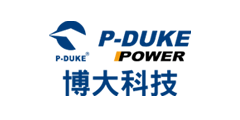
The reduction of CO2 emissions has become a worldwide goal and has led to the development and research of many new technologies. Higher efficiencies in the complete power chain and new ways to store energy are needed.
To replace fossil fuels with renewable energy sources, there is the possibility of using the energy of the sun, wind, water, biomass as well as geothermal energy. While biomass and geothermal energy provide a constant energy yield, this is not the case with energy generated from the sun, wind, or waves. Solar energy generated during the day must be stored for the night. The same applies to wind energy, as the turbines no longer supply energy during a wind calm.
All these new technologies require electronic control circuitries, which need to be powered from various sources. The following article will explain challenges and solutions.
One of the growth markets is e-mobility, and the EU has decided, for example, that no new vehicles with a classic combustion engine may be sold after 2035. Other regions have decided on similar bans and the change to e-cars will require many public and private charging stations supplied from the different worldwide AC grids (figure 1).
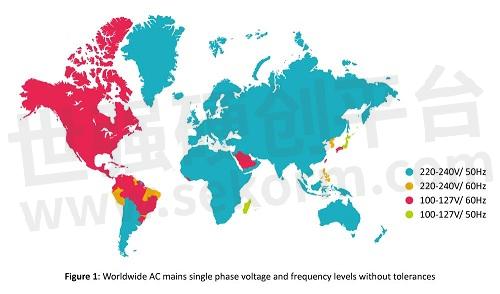
The worldwide AC mains voltages range from 85Vac up to 264Vac and many power supplies today can work over this full range.
An additional challenge in energy applications comes from the fact, that equipment like power chargers or wall boxes are hard-wired directly to the fuse panel. This means they are more exposed to transients on the grid than equipment connected to an outlet by cables and plugs and therefore have to be compliant to overvoltage category III (OCV III) with isolation barriers of 4kVac (figure 2). This also applies to the auxiliary power supplies used inside the chargers or wall boxes.
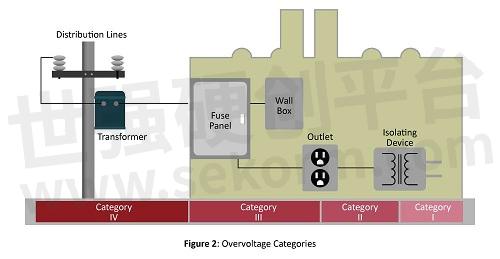
These systems also have to be tolerant to faults in the mains wiring or the neutral. A phase accidentally connected incorrectly during installation, or a break in the neutral even in the neighborhood can lead to unbalanced systems and therefore higher voltages. The mains input voltages are therefore monitored to disconnect the expensive high-power stages in case of such a failure.
This monitoring circuitry must work under all circumstances and P-DUKE therefore offers a series of small AC/DC converters not only compliant to OVC III but also operating over the extremely wide range of 85 to 530Vac. Even if a phase is connected to neutral by error, the auxiliary supply and the monitoring circuitry work and can protect the power stage.
Modern systems should be ready fo r the integration in a smart grid or smart home environment. This allows controlling the system to match the actual availability of power in a grid. Car batteries can be charged when a surplus of energy is available and work as energy buffers stabilizing the grid. Household appliances with high energy consumption will be switched on only when there is enough energy available.
This means more interphases to communicate with the grid or smart home controller. Supply voltages for interphases, displays, touch panels or relays can range from 3.3V up to 24V and can be generated from the auxiliary supply voltage bus with small isolated or non-isolated converters (figure 3).
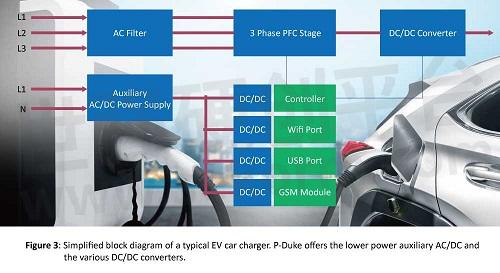
As mentioned at the beginning of the article, the integration of renewable energies also requires an expansion of storage options due to the non-constant energy flow. Hydroelectric power plants are already used for this purpose today by pumping water back into the reservoir when there is a surplus of energy. However, their capacity is limited and the most obvious way to store energy would be to use batteries.
Lead-acid batteries have been used for decades but they are heavy, energy density is relatively low, the charging process is slow, and they can only be charged about 300 - 600 times.
Lithium batteries have several advantages over lead-acid batteries. For example, they are not only much lighter and smaller than lead-acid batteries, but they can also be charged faster and reach several thousand charge cycles. This makes them ideal for use in mobile devices as well as e-vehicles.
But they require materials whose availability is limited and some of which are obtained under problematic conditions. Per kilowatt-hour of capacity a typical e-car battery needs not only 120 – 180 grams of lithium but also some other materials with limited availability. According to a study from ADAC, a German automobile club, the 50kWh battery of a-car contains around 4kg lithium, 11kg manganese, 12 kg cobalt, 12kg nickel and 33kg graphite.
To change mobility away from combustion engines to e-drives, hundreds of thousands of tons of these materials will be needed in the future. Methods to recycle this material are complex and according to experts partly still in the development or testing phase. Therefore, alternatives are being sought, not only in battery technologies but also in the way electrical energy is stored.
You may have heard of batteries based on aluminum - sulfur, sodium ions, carbon - copper, or iron - oxygen. Not available yet for the mass market, these are options to use material that is available in large quantities and is also less problematic to mine.
For a non-mobile application, size and weight of the batteries are also not so important. In the base of a wind turbine tower, there is plenty of space even for larger batteries. When there is a surplus of energy in the grid, the energy generated by the turbine could be stored there and fed into the grid when there is an energy shortage. Often, energy only needs to be temporarily stored in a grid for a period of 12 to 24 hours.
But each battery technology has different voltages, a real challenge if someone wants to design future-proof systems compatible to the different battery technologies and number of cells used in an application. Power supply manufacturers like P-Duke therefore offer converters with input voltage ranges from 2:1 up to 12:1. With these converters it is possible to cover many different battery technologies.
Supercaps are an interesting alternative to batteries as they offer longer lifetimes, up to 1 million charging cycles and very high charging currents. Unlike batteries, supercaps are not damaged by a deep discharge. They are ideal for applications with power demands of less than 1-2 minutes but a very high number of charging cycles. Why not using supercaps on a transport robot in a warehouse that only travels short distances and can then be recharged in seconds. Unlike batteries, the output voltage of supercaps depends very much on the state of charge. As most electronic loads need a stable voltage, DC/DC converters with very wide input ranges are needed.
And there are many other ways to store energy. With electrolysis hydrogen can be obtained from air. In a further process step methane, the main component of natural gas can be produced. Both gases can be stored, transported, and used as fuel, e.g., in a fuel cell, another strongly emerging technology. Even drones are using fuel cells nowadays.
Other ways to store mechanical energy for later use are gas pressure and flywheel storage devices. Over 15 years ago a start-up in the USA wanted to use compressed air for wind turbines but it was never realized because the solution was too complex and inefficient. But there are still projects working on storing excess energy from wind turbines in compressed air.
First gyro buses came to the market in 1950, where able to recover the braking energy but needed a charging station every 4-6 kilometers, not suitable for modern public transport. Today flywheel storage devices are mainly used to deliver high power for a short time, for example to stabilize a grid.
These were just a few examples; the energy market is complex, there are thousands of options and new ideas and technologies appear almost daily, each placing different requirements on the power supplies needed. In addition, for energy-efficient, widespread use, modern systems must communicate with each other. All these systems need regulated supply voltages to be generated from a wide variety of sources.
The AC grid voltage levels and transient specifications are set for many years now and companies like P-Duke offer a wide variety of AC/DC power supply solutions meeting the various requirements (figure 4, P-Duke’s AC/DC solutions)
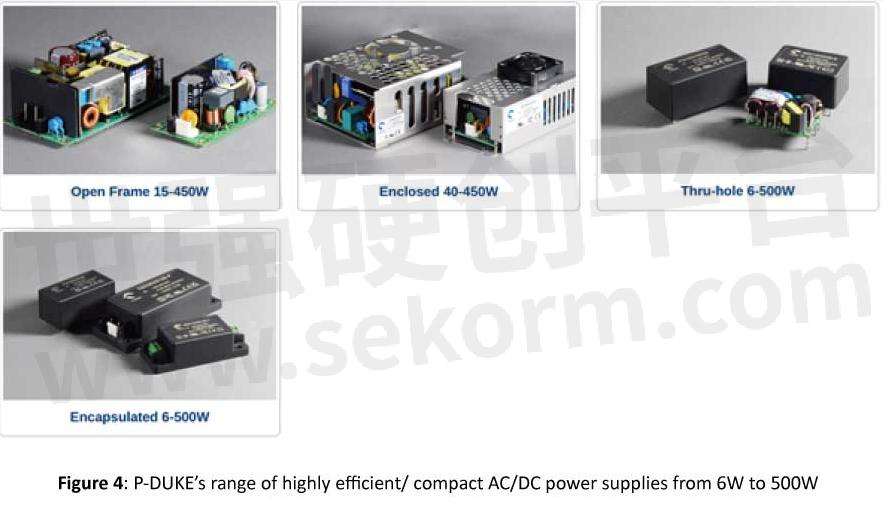
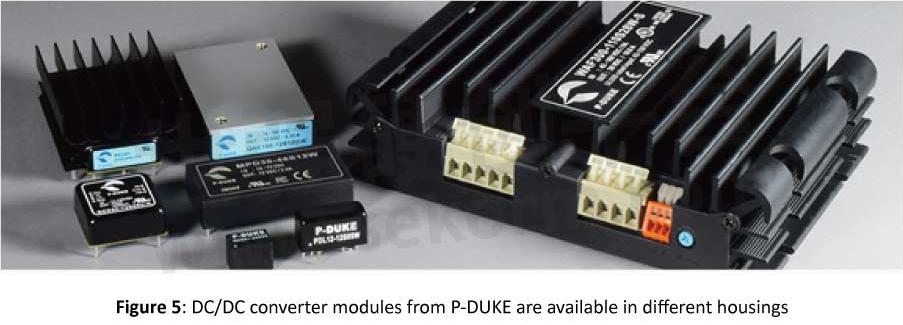
For DC sources the situation is more complex also because new systems are expected to come to the market. But solutions are available today. In the telecom and the railway market different battery voltages had been used for decades. System manufacturers in these markets want to offer one solution and therefore power supply manufacturers like P-Duke designed converter families covering even the extremely wide input ranges of 16V up to 160V in railway applications and achieving power levels up to 200W. With their standard output voltages from 5V up to 53V, these converters can be used for many different battery voltages in all types of energy market applications
LAN, WLAN, GSM and other communication modules, safety and monitoring devices, displays, touch panels or relays, they all need regulated supply voltages, with or without isolation from the internal control circuitry. Within the broad range of converters it should be easy for a designer to find a ready-to-use solution. (figure 6)

All these converter modules are easy to deploy and therefore plug-and-play solutions not only during the design phase but also in case of later changes in the input, output or power specification of a system. This makes every design future-proof and ready for an emerging market with many new opportunities but also still many unknowns.
- +1 Like
- Add to Favorites
Recommend
- Encapsulated AC/DC Power Supplies MSD and TSD Series Provide Output Power of 40 to 65W for Industrial and Medical Applications
- P-DUKE Compact Design Medical 150W AC/DC Power Supplies with Conversion Efficiency Up to 94%
- P-DUKE Rugged 500W AC/DC Power Supplies XTBF500 Utilizing Conduction Cooling Are Dedicated to Harsh Environments
- Agility EMS & SL Power to Offer New High-performance Internal Power Supplies and Desktop/wall-mount Power Supplies
- P-DUKE Launches New TAF300 Series 300 Watt Industrial Grade AC/DC Power Supplies in 4”x2” Size with 93% Conversion Efficiency
- P-DUKE New MAF300 Series Open-Frame 300 Watt Medical Grade AC/DC Power Supplies, with Compact Design and Highest Insulation of 2xMOPP
- SL Power Electronics, Global Supplier of Medical/Industrial Power Products, Offering AC/DC and DC/DC Power Conversion Solutions
- AC/DC Power Supply SM Series: Reliable and Efficient Solutions for Your Power Needs
This document is provided by Sekorm Platform for VIP exclusive service. The copyright is owned by Sekorm. Without authorization, any medias, websites or individual are not allowed to reprint. When authorizing the reprint, the link of www.sekorm.com must be indicated.





























































































































































































































































































































































































































































































































































































































































































































































































































































































